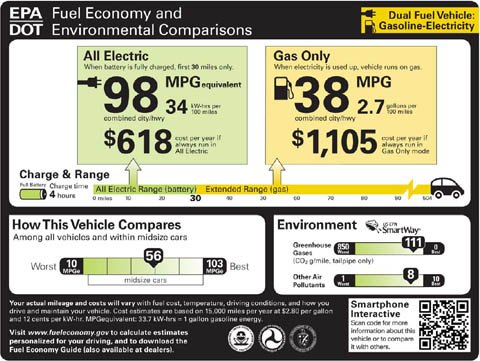Is the EPA Fudging EV MPGe Figures?

Is the US EPA fudging the way it calculates miles per gallon equivalent ratings for electric and hybrid cars, making EVs appear to be more energy efficient than they really are, increasing their consumer appeal? That’s what Lindsay Leveen, author of Hydrogen – Hope or Hype? A Primer on Energy and Sustainability, says.
The U.S. Environmental Protection Agency calculates MPG ratings based on energy at point of delivery. That means that it ignores the energy costs of drilling, pumping, refining and transporting the gasoline to the corner gas station. When calculating miles per gallon equivalent (MPGe) ratings used to evaluate fuel costs for electric vehicles and hybrids, the EPA also ignores the energy costs of producing and transmitting electricity as well as the energy costs of transforming transmission line voltage to 110/220 VAC and then losses in converting to the Direct Current needed to charge batteries. The EPA also assumes that EV batteries have a charge/discharge efficiency of 100%. Essentially the EPA is treating EVs as though electricity is 100% efficient until it gets to the vehicles’ motors. You could say it does the same for gasoline, not looking at the total energy costs of getting that fuel to market. The agency then mileage tests EVs, dividing electricity consumed by an energy conversion factor of 33.7 kilowatt hours per gallon of gasoline to arrive at MPGe ratings.
So what’s the problem? As long as the EPA is evaluating energy costs at the point of delivery, it’s comparing apples to apples, right? Well, it seems as though some apples take more energy to plant, grow and get to the fruit market than other apples. It’s true that there are extraction, processing and transportation energy costs for all fuels, including the coal, natural gas and uranium used to generate electricity as well as for gasoline. Drilling, pumping, and refining crude oil plus trucking and dispensing gasoline consumes the equivalent of about 10% of the energy in the crude oil.
That 10% energy cost is comparable to the 90% efficiency of electrical transmission lines and local distribution systems, or the 90% efficiency of AC/DC conversion and battery charge/discharge cycles. Those 90% efficiencies, though, if I remember my math terms correctly, are associative – together they yield 81% efficiency, not 90%. Of course, with gasoline, unlike electrical generation, that 10% energy cost is all that’s involved.
You may use some energy getting petroleum out of the ground and then turning it into a useful fuel, but electricity generation that isn’t hydro or geothermal necessarily involves consuming fuel, either fossil or nuclear. Most of America’s energy comes from coal fired power plants. In the near term, what won’t get generated from coal will probably be generated from natural gas (owing to the ongoing boom in gas discoveries and production), not wind and solar power (which have their own energy costs).
Essentially, to run an electric vehicle you’re converting chemical or nuclear energy into heat into electricity. As we know from internal combustion engines, turning chemical energy into heat into power involves waste heat. As Leveen seems to enjoy saying, you cannot avoid the Second Law of Thermodynamics. Entropy exists. Average energy efficiency of electrical power plants is about 42.5%. Multiplying all the efficiencies in getting electricity generated and charged into your car’s battery pack and you come up with 34.4%.
That means that the EV version of the Honda Fit’s EPA rating of 118 MPGe, multiplied by electricity’s inefficiencies, would actually work out to 40.6 MPG. A conventional petrol fired Fit has a combined EPA rating of 35 MPG. Taking that 10% energy cost of production and distribution of gasoline into consideration yields 31.5 MPG. While that still puts the EV Fit as 29% more fuel-efficient than the gasoline version, that’s not nearly as impressive as triple digit MPGe figures. If you’re running a government agency that wants to encourage the sale of electric cars, using the larger figures might make sense but then political science and real science, as Leveen points out, aren’t the same thing.
Ronnie Schreiber edits Cars In Depth, a realistic perspective on cars & car culture and the original 3D car site. If you found this post worthwhile, you can dig deeper at Cars In Depth. If the 3D thing freaks you out, don’t worry, all the photo and video players in use at the site have mono options. Thanks for reading – RJS

Ronnie Schreiber edits Cars In Depth, the original 3D car site.
More by Ronnie Schreiber
Latest Car Reviews
Read moreLatest Product Reviews
Read moreRecent Comments
- CanadaCraig My 2006 300C SRT8 weighs 4,100 lbs. The all-new 2024 Dodge Charge EV weighs 5,800 lbs. Would it not be fair to assume that in an accident the vehicles these new Chargers hit will suffer more damage? And perhaps kill more people?
- Akila Hello Everyone, I found your blog very informative. If you want to know more about [url=
- Michael Gallagher I agree to a certain extent but I go back to the car SUV transition. People began to buy SUVs because they were supposedly safer because of their larger size when pitted against a regular car. As more SUVs crowded the road that safety advantage began to dwindle as it became more likely to hit an equally sized SUV. Now there is no safety advantage at all.
- Probert The new EV9 is even bigger - a true monument of a personal transportation device. Not my thing, but credit where credit is due - impressive. The interior is bigger than my house and much nicer with 2 rows of lounge seats and 3rd for the plebes. 0-60 in 4.5 seconds, around 300miles of range, and an e-mpg of 80 (90 for the 2wd). What a world.
- Ajla "Like showroom" is a lame description but he seems negotiable on the price and at least from what the two pictures show I've dealt with worse. But, I'm not interested in something with the Devil's configuration.


































Comments
Join the conversation
MPGe is an attempt to compare apples to oranges. It is therefore a distortion and it proves nothing.
"The EPA also assumes that EV batteries have a charge/discharge efficiency of 100%. Essentially the EPA is treating EVs as though electricity is 100% efficient until it gets to the vehicles’ motors." What? NO! The EPA gets the MPGe number from the power being inputted to the charging port in the car. So the EPA doe account for inefficiencies with charging the battery pack and delivering power to the electric motor(s). I don't believe it takes into account the inefficiency of the external charger. I can't believe I saw the quoted text in this article because it isn't true.